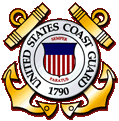



![]()


![]()
LV-116
/ WAL-538 1933-1942:
LV-116 on station.
YEAR BUILT: 1930
BUILT AT: Charleston (SC)
APPROPRIATION: ?
BUILDER: Charleston Drydock & Machine Co
CONTRACT PRICE: $274,434
SISTER VESSELS: LV 100,113,114,115,117
DESIGN: Diesel-electric propelled; steel hull; steel deckhouses; 2 masts, smokestack amidships
LENGTH: 133'3" (loa); BEAM: 30'0"; DRAFT: 13'0"; TONNAGE: 630 displ
PROPULSION: Diesel-electric - one 350 HP electric motor driven by any or all of four 75 KW diesel engine/generator units; 350 SHP @ 300 RPM; 5'9"dia propeller; max speed 10 knots, average 9 knots
ILLUMINATING APPARATUS: 375mm electric lens lantern at each masthead
FOG SIGNAL: Electric diaphragm horn using 4-way multiple horn; hand operated bell
CONSTRUCTION NOTES - MODIFICATIONS - EQUIPMENT
CHANGES & IMPROVEMENTS: LV 116-
Launched Oct 22, 1929; completed Aug 14,1930-
Equipped with radio and submarine bell when built-
1933: Equipped with radiobeacon-
1935: Fog signal changed to air diaphone F2T-
1945: Fitted with detection radar-
1964: USCG lists vessel with duplex 375mm lens lantern on foremast,
13,000cp
each lamp; AN/SPN-l1 radar; other characteristics as shown above-
Radio and visual call sign NMJD (1940-1970)
STATION ASSIGNMENTS: LV 116 / WAL 538
1930-1933: Fenwick Island Shoal (DE)
1933-1942: Chesapeake (VA)
1942-1945: Examination Vessel, WWII
1945-1965: Chesapeake (VA)
1965-1970: Delaware (DE)
(Fenwick station discontinued Jun 30, 1933)
(1942-1945 during WWII, withdrawn from Chesapeake station, assigned to
1st District based at Sandwich (MA) and used as examination vessel off
northern entrance to Cape Cod Canal; armed with two 20mm/8O)
(Chesapeake station discontinued 1965)
(Delaware station discontinued 1970)
HISTORICAL NOTES: LV 116/WAL 538-
1936 Sep17/18, in track of hurricane, parted chain and adrift; dropped spare anchor and ran full ahead for 10 hours to reduce dragging; motor launch and whaleboat damaged, dory carried away; relieved for repair Sep 19 and took station again Sep 25
More notes:
RETIRED FROM LIGHTSHIP DUTY: 1970; AGE: 40
SUBSEQUENT DISPOSITION: Decommissioned Aug 25, 1970;
transferred to National
Park Service Aug 25, 1971 and on display at Hams Point, Washington DC
until
1980; moved in 1982 to Baltimore Harbor Place, Constellation Dock; afloat
and
open to public. Maintained by Coast Guard Reserve unit. Marked CHESAPEAKE
COMMANDING OFFICERS: LV 116 / WAL 538
1930-1937: Alexander Andrews, Master
1937-?: Robert E Tillette, Mate
1964: CWO G H Yarrington, CO
Background: History of LV-116:
by,
Frank F.
Hebblethwaite Historian
When the U.S. Lighthouse Service light vessel, LV-116, was built in 1930 at Charleston, South Carolina, the number of total lightships in Government service had declined from what it had been prior to 1930. But the organization of the Lighthouse Service in general and the condition of lightships in particular, had greatly improved. Built at a cost of $274,434.00, LV-116 was much better prepared to serve its function than were the lightships of the nineteenth and early twentieth centuries. If the main anchor snapped in a storm, there was an auxiliary anchor to take its place. If the 30,000 candle power light with its Fresnel lense went out, there was another one to replace it. With practically every piece of vital equipment backed up by a replacement, LV-116 was well equipped to maintain its station through most any calamity.
With the Norwegian Alexander Andersen at the helm, the 630-ton, 133-foot long LV-116 left for its first tour of duty at Fenwick Island, Delaware, on August 17, 1930. As lightships generally took on the name of their duty stations, LV-116 was known as the Fenwick until June 30, 1933. On July 17, 1933, LV-116 first acquired the name Chesapeake. Until 1939, it was stationed in Virginia waters at the mouth of the Chesapeake Bay. The crew's endless hours of routine duty were broken by many a violent storm. The crew also spent time gathering data for meteorological and oceanographic studies. Through it all, the "Chesapeake" served its station faithfully.
In 1939, the Lighthouse Service and all of its ships were absorbed into the U.S. Coast Guard and light vessel #116 was redesignated and renumbered as WLV-538 [W stands for Coast Guard vessel, LV for Light Vessel and "538" became her Coast Guard hull number]. It was with some bitterness that the Civil Service-staffed Lighthouse Service was absorbed by the more "mechanical" and military Coast Guard. For seamen, it meant a cut in pay from $62.50 a month to $36.00 a month which was what an enlisted man in the Coast Guard got paid at that time. All crewmen would now have to wear uniforms and sign up for a three year or six year hitch. Many an old veteran resigned rather than make the transition. A number of captains with no military background and little education were replaced by Coast Guard Academy-trained officers. All men would also have to pass a Coast Guard physical examination. However, the Coast Guard did mean more efficiency, better equipment and better communication with shore.
As with all other Coast Guard vessels, the Chesapeake was pressed into service with the U.S. Navy during World War II and it served as an examination vessel off of Sandwich, Massachusetts. Released from its duty with the Navy in the summer of 1945, WLV-538 returned to duty at the mouth of the Chesapeake Bay. While on duty in 1962, the ship survived a severe storm during which one mountainous wave buckled in the forward bulkhead of the pilot house. It was the third storm the Chesapeake had weathered in which its anchor chain had snapped. The other two occurred in 1933 and then again in 1936. The Chesapeake remained on active duty in the Bay until September, 1965, when the advance of technology caught up with it. Its station was taken by a giant "Texas Tower," similar to oil rigs in the ocean. Easily accessible by helicopter, these new light stations are not nearly as isolated as lightships. They are also less expensive to maintain and they have a much longer life expectancy. In fact, only five lightships have been built since the Chesapeake.
The Chesapeake's last tour of duty, from 1966 until June, 1970, was at the entrance to the Delaware Bay. At that time, it was replaced by a Large Navigational Buoy or LNB. This type of buoy weights 104-tons and has a base 40-feet in diameter, and is completely automated. It can operated for months without servicing and costs only a fraction of the amount needed to maintain a lightship. Moth-balled at Cape May, New Jersey, from July, 1970 to December, 1970, the Chesapeake was decommissioned on January 6, 1971.
 By going back to more
Lightship Stations and the Ships that Served on them.
By going back to more
Lightship Stations and the Ships that Served on them.
![]()
Copyright © 2003 United States Coast Guard Lightship Sailors Association
INC. All rights reserved.
Copyrights also protected by the Digital Millennium Copyright Act of
1998
Revised: 10/23/06.